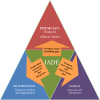Prevention and Care Programs Addressing the Growing Prevalence of Diabetes in China
- PMID: 27796780
- PMCID: PMC5085990
- DOI: 10.1007/s11892-016-0821-8
Prevention and Care Programs Addressing the Growing Prevalence of Diabetes in China
Abstract
According to a 2010 national survey, 11 % of adults in China have diabetes, affecting 109.6 million individuals. The high prevalence of diabetes has been attributed to the aging of the population, the rapid adoption of energy-dense foods, and a reduction in physical activity. Collectively, these secular changes have created an obesogenic environment that can unmask diabetes in subjects with a genetic predisposition. The growing prevalence of maternal obesity, gestational diabetes, childhood obesity, and early-onset disease can lead to premature morbidity and mortality. Rising to meet these public health challenges, researchers in China have conducted randomized studies to demonstrate the benefits of lifestyle modification in preventing diabetes (the Da Qing Study), as well as that of team-based integrated care, using multiple strategies including peer support and information technology, in order to reduce hospitalizations, cardiovascular-renal complications, and premature deaths. With growing evidence supporting the benefits of these diabetes prevention and management programs, the next challenge is to use policies and systems to scale up the implementation of these programs through raising awareness, building capacity, and providing resources to reduce the human and socioeconomic burden of diabetes.
Keywords: Diabetes management; Integrated care; Patient empowerment; Peer support.
Conflict of interest statement
Junmei Yin declares no conflict of interest. Alice P. S. Kong has received honorarium for consultancy or giving lectures from Abbott, AstraZeneca, Sanofi, Novo-Nordisk, Eli-Lilly, Merck Serono, Pfizer, and Nestle. Juliana C. N. Chan has received research grant and/or honorarium for consultancy or giving lectures, from Bayer, Boehringer Ingelheim, Daiichi-Sankyo, Eli-Lilly, GlaxoSmithKline, Merck Sharp and Dohme, Merck Serono, Pfizer, AstraZeneca, Sanofi, Novo-Nordisk, and/or Bristol-Myers Squibb. The proceeds have been partially donated to the Chinese University of Hong Kong, American Diabetes Association, and other charity organizations to support diabetes research and education. She is the Chief Executive Officer of the Asia Diabetes Foundation, a non-profit research organization under the governance of the Chinese University of Hong Kong, on a pro bono basis. The web-based JADE Program was designed and implemented by the Asia Diabetes Foundation. Human and Animal Rights and Informed Consent This article does not contain any studies with human or animal subjects performed by any of the authors.
Figures
Similar articles
-
Leading a healthy lifestyle: the challenges for China.Asia Pac J Public Health. 2010 Jul;22(3 Suppl):110S-116S. doi: 10.1177/1010539510373000. Asia Pac J Public Health. 2010. PMID: 20566542
-
Diabetes in the Middle East: Government Health Care Policies and Strategies that Address the Growing Diabetes Prevalence in the Middle East.Curr Diab Rep. 2019 Feb 4;19(2):8. doi: 10.1007/s11892-019-1125-6. Curr Diab Rep. 2019. PMID: 30715611 Review.
-
Diabetes care in China: meeting the challenge.World Hosp Health Serv. 2005;41(3):29-30, 32. World Hosp Health Serv. 2005. PMID: 16300163
-
Socioeconomic factors relating to diabetes and its management in India.J Diabetes. 2016 Jan;8(1):12-23. doi: 10.1111/1753-0407.12316. Epub 2015 Jul 30. J Diabetes. 2016. PMID: 26019052 Review.
-
Current scenario of diabetes in India.J Diabetes. 2009 Mar;1(1):18-28. doi: 10.1111/j.1753-0407.2008.00004.x. Epub 2008 Dec 17. J Diabetes. 2009. PMID: 20923516 Review.
Cited by
-
Autophagic dysfunction of β cell dysfunction in type 2 diabetes, a double-edged sword.Genes Dis. 2020 Mar 19;8(4):438-447. doi: 10.1016/j.gendis.2020.03.003. eCollection 2021 Jul. Genes Dis. 2020. PMID: 34179308 Free PMC article. Review.
-
Service users' experiences of, and engagement with, a nationally implemented digital diabetes prevention programme.Br J Health Psychol. 2025 Feb;30(1):e12787. doi: 10.1111/bjhp.12787. Br J Health Psychol. 2025. PMID: 39968862 Free PMC article.
-
Description of the nationally implemented National Health Service digital diabetes prevention programme and rationale for its development: mixed methods study.BMC Health Serv Res. 2023 Apr 18;23(1):373. doi: 10.1186/s12913-023-09210-3. BMC Health Serv Res. 2023. PMID: 37072758 Free PMC article.
-
Diabetes advocacy in the Asia-Pacific region.J Diabetes Investig. 2025 Jul;16(7):1191-1201. doi: 10.1111/jdi.70084. Epub 2025 May 27. J Diabetes Investig. 2025. PMID: 40421836 Free PMC article. Review.
-
Gestational weight gain targets during the second and third trimesters of pregnancy for women with gestational diabetes mellitus in China.Eur J Clin Nutr. 2019 Aug;73(8):1155-1163. doi: 10.1038/s41430-018-0358-9. Epub 2018 Oct 30. Eur J Clin Nutr. 2019. PMID: 30375492 Free PMC article.
References
-
- China. National Bureau of Statistics of the People’s Republic of China. 2014. http://www.stats.gov.cn/. Accessed 2014.
-
- A mass survey of diabetes mellitus in a population of 300,000 in 14 provinces and municipalities in China (author’s transl). Zhonghua Nei Ke Za Zhi. 1981;20(11):678–83. - PubMed
Publication types
MeSH terms
LinkOut - more resources
Full Text Sources
Other Literature Sources
Medical


